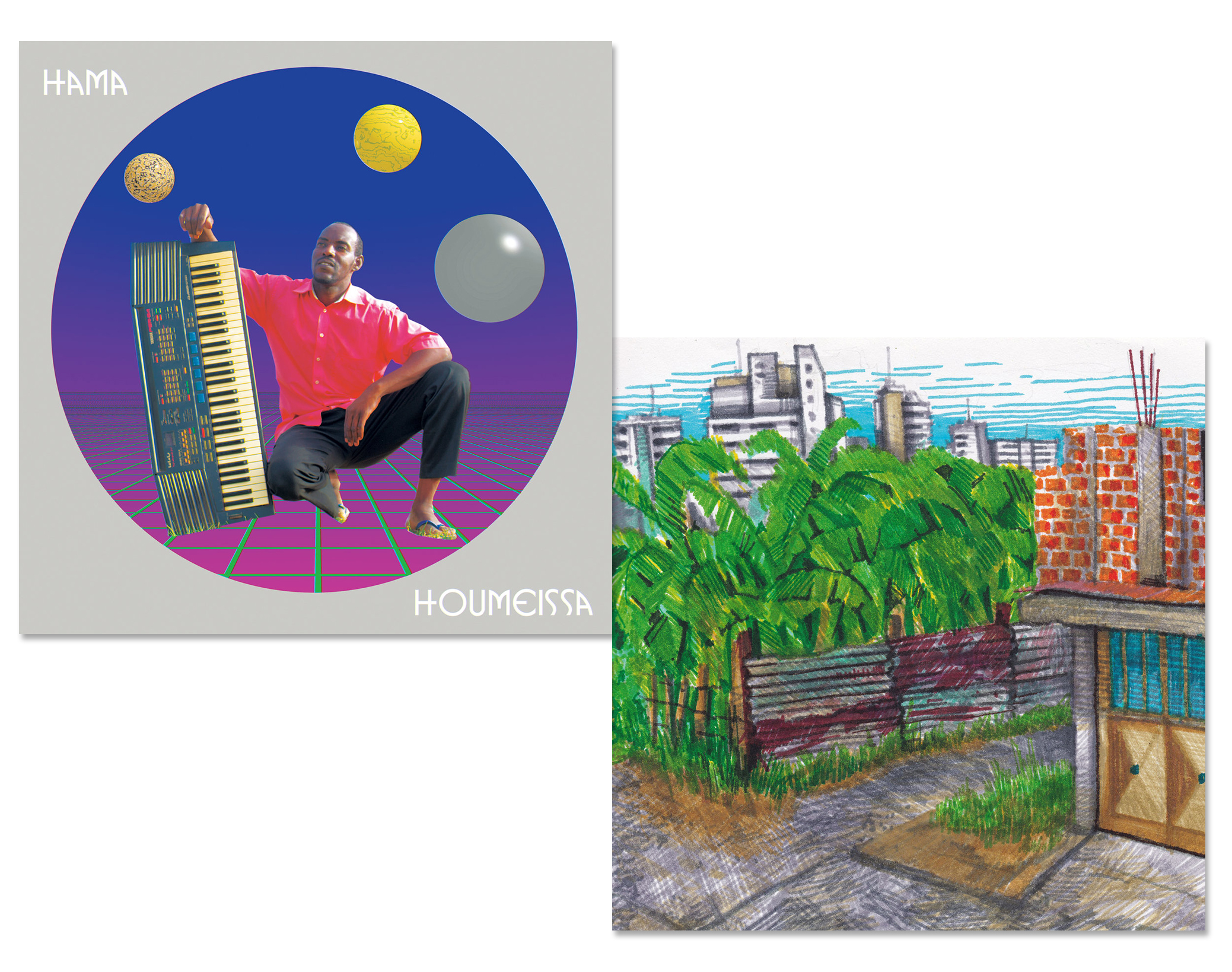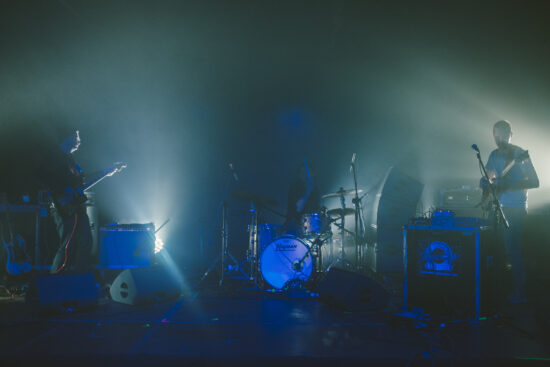Columbian Romperayo on “Que Jue?” offers such a colourful, contemporary, and unrestrained interpretation of cumbia, while Hama on “Houmeissa” makes an entirely different story: cosmic, multi-layered music, which builds a bridge between tradition and futurist sounds.
Translation: Aleksandra Szkudłapska
South America and Africa are without a doubt two continents, whose traditional music has made the greatest impact on global mainstream. This is also where – in different countries, each of which boasts its own rich musical culture – ever younger artists are creatively revamping these traditions, shaping them into an utterly modern and attractive form. The melodies and rhythms of local genres are given new interpretations and interwoven with contemporary sounds to build a broad panorama of musical history, with which subsequent generations are more and more inclined to identify (I strongly suggest you follow Basy Tropikalne – a radio show and initiative promoting the contemporary music scene of both continents). And what’s even better is when local folk music merely serves as a point of departure to create something very contemporary and original – like in the case of the latest albums by Colombia’s Romperayo and Niger’s Hama. Both records have more in common than being made by solo artists: a skilful and imaginative use of electronica, a predilection for acid synthesizer passages, and transforming the rhythm layer in a manner that is in equal parts peculiar and creative.
A lot may be said about the music of both continents. A special term was even coined for South America: New Weird South America – slightly tongue-in-cheek, but also referring to the earlier phenomenon of New Weird America. This umbrella term defines a number of bands that look at their musical heritage from the angle of contemporary electronica, use of samples and employing traditional sounds to create new club music. The Colombian scene is steadily gaining momentum, and one of its most notable representatives is the drummer Pedro Ojeda (member of such bands as Frente Cumbiero, Los Pirañas or Chúpame El Dedo with Eblis Javier Álvarez, founder of the equally interesting Meridian Brothers). Ojeda started Romperayo, a laboratory project inspired by archive records of 50s, 60s, and 70s Colombian music, which he began to layer with synthesizers. While his debut album, released in 2015 – by Discrepant label, which discovers many musical lands – was recorded with a full band (including Álvarez), Que Jue? is a solo effort.
The most important element of this music is its evocative rhythm, typical of cumbia – Colombia’s national dance. Ojeda’s brilliant command of a large percussion set attracts attention in all tracks, but there is something deeply psychedelic about his approach to folk music. Que Jue? is not just based on percussion and instruments, but also on samples that regularly shine on the record. Where the debut was a cocky collective effort, based on playing together and having fun as a group, openness and a predilection for change, the second album is driven by a linear narrative that borders on sampling and drumming cascades. This is evident in the fast-paced “El Tombo Volador”, where the trance-like cumbia rhythm serves as an ideal base to play about with a sizeable collection of samples and additional sounds. In turn, the opening “Que jue?” and “Ay Que Pulguita” are an almost classical turn towards cumbia, enhanced with acid synthesizers and quasi-orchestral samples. “Maquino Ladero” slows down, and accordion – typical for the genre – takes centre stage. Ojeda’s music is cheerful and unrestrained, yet not devoid of experimentation (his entire creative practice being one big experiment). “Estudio corto para sintetizador en cumbia genérica” is – as the title suggests – a brief, yet powerful intermission, demonstrating that a mix of synthesizers and cumbia may also verge on the avant-garde. Above all, Que jue? is a collection of brief, but in-depth pieces, which are amazingly light and witty in their combination of samples and instrumentals. The piercing trumpet in “Machuca, Millo y Caja” may have been both recorded live or used as a sample (I personally bet on the latter) – but this is essentially of secondary importance. What really matters is Ojeda’s dense, multi-layered work, which offers such a colourful, contemporary, and unrestrained interpretation of cumbia.
Hama is another artist who exemplifies a thoroughly modern (futuristic even) approach to tradition. His album was released by Sahel Sounds, a label focusing on the music of the Tuareg people, who inhabit a vast area of the Sahara, including Algeria, Libya, Mali, Niger, and Burkina Faso (this is by no means a closed list, as you may find out from this fascinating documentary). Most of this music is guitar-based, either closer to rock (Mdou Moctar who played a brilliant show at Tremor 2018) or folk (Les Filles de Illighadad). You may also – though perhaps not as frequently – find electronica on the label, but Hama remains a phenomenon. He’s a genuine musical freak, who works as a taxi driver (think Hailu Mergia) – so he needs a lot of time to create new music. He reaches for the Tuareg tradition, but grinds this desert music into an electronic, dance format. He follows in the footsteps of Mammane Sani, who on the one hand eagerly built melodies full of primitive beats, but on the other, did that with enthusiasm worthy of Felix Kubin. Hama presented his first ideas on Torodi, released four years ago, but a lot of his unofficial music has since been released in various forms (you could also hear it played at weddings).
Yet where his debut album translated Tuareg music into simple keyboards and coarse electronics – recorded on a Yamaha PSR-64, which could be programmed in Arabic scales – Houmeissa is an entirely different story: cosmic, multi-layered music, which builds a bridge between tradition and futurist sounds. Hama’s daring synthesizer arpeggios create a peculiar type of road music, distilling the essence of folk traditions into a colourful interpretation marked with new age and Detroit techno. “Bororo” is built using looped, reverberating keyboards and a simple beat, which gradually transforms into a monumental sound. The title piece is an acid interpretation, and “Takamba” spirals into a piercing, psychedelic vortex, both in the original version and the brilliant remix.
Delicate synthesizer sounds and computer-generated guitars are used to deconstruct the musical tradition, kickstarting it onto a new level. Multi-layered synthesizer polyrhythms are present on several planes, adding a desert and cosmic, but also song-like reference to the 1980s. The end-result is all the more evocative because they were recorded on FruityLoops (Yamaha’s limitations finally made themselves felt), a relatively simple software. The interpretation isn’t as obvious as Romperayo’s take on cumbia – these nomadic ballads and wedding songs have been transformed into a soundtrack as if taken out from a sci-fi movie. But like Ojeda, Hama effortlessly hits points of convergence with the contemporary electronic scene. The music of both artists is informed by the past and traditional arrangements, and yet not locked within them – they carefully digest their inspirations, arriving at a very contemporary and forward-looking sound.
LISTEN:
Romperayo: 🎵Spotify 🎵Tidal 🎵Deezer 🎵Apple Music
Hama: 🎵Spotify 🎵Tidal 🎵Deezer 🎵 Apple Music
Romperayo Que Jue?, Discrepant.
Hama, Houmeissa, Sahel Sounds.




